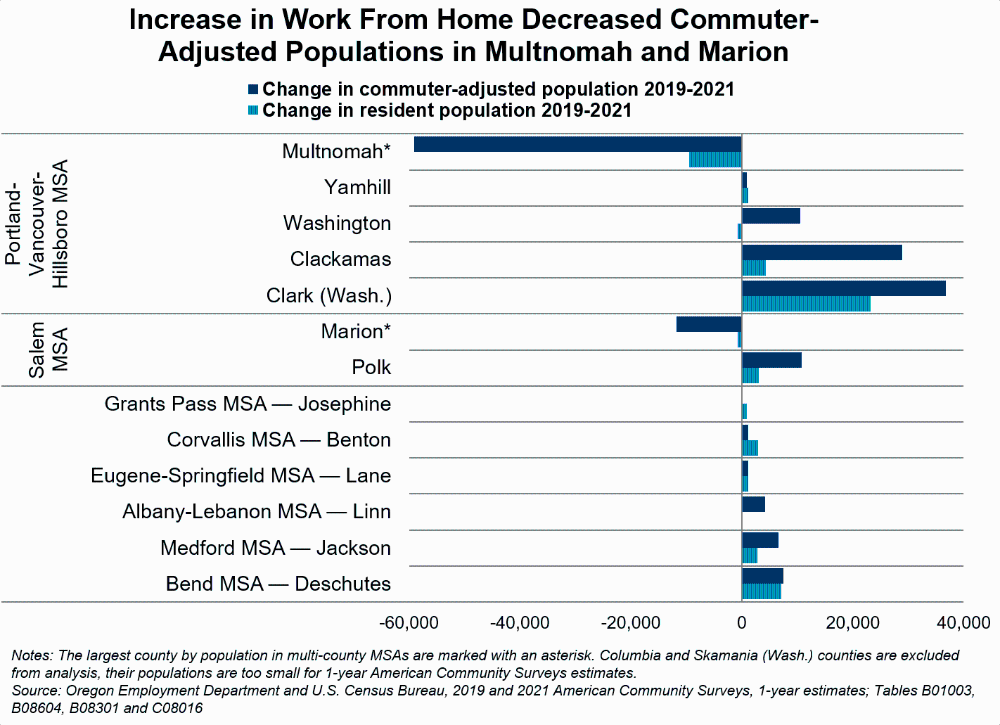Oregon’s Urban Cores Saw Steep Declines in Commuter-Adjusted Population
August 16, 2023More people now work from home, and that has affected the number of people that work in traditional centralized employment areas, like Portland and Salem. A way to measure this change is through looking at the commuter-adjusted population, which estimates the number of people in a geographic area during normal business hours.
The commuter-adjusted population is calculated using American Community Survey data to estimate the number of people that live and work in an area during normal business hours. It is a measure of how a region’s foot traffic changes due to regular work commuting. It is not a complete measure of change in population composition as it excludes students, tourists and shoppers. Additionally, it ignores any differences in travel that may occur day-to-day.
This article looks at Oregon’s eight metropolitan statistical areas (MSAs) as they are the most populous areas and traditional centralized employment locations in Oregon. Of the eight, only two include more than one county. The Portland-Vancouver-Hillsboro MSA (hereafter Portland MSA) is comprised of seven counties (two of which are in Washington state) and the Salem MSA consists of two.

Of the MSAs in Oregon, the Portland MSA saw far and away the largest changes in commuter-adjusted population. Multnomah County, the largest county in the MSA by population, saw its commuter-adjusted population decline by about 59,000 people. This is in contrast to the surrounding suburban counties that all saw an increase in commuter-adjusted population. The opposing trends within the Portland MSA were likely caused by employee, employer, and resident decisions. It is likely fewer people chose to commute into Multnomah from the surrounding areas and chose to tele-commute or work from home instead. Businesses could have moved out of the county or decided to go fully remote. Additionally, some residents may have migrated out of Multnomah to surrounding counties.
Of the Portland MSA suburban counties, Clark (in Washington State) saw the largest increase, seeing over 35,000 more people in the county during normal working hours. However, a large part of that increase is due to the expansion of the resident population. An increase in work from home is more apparent in Clackamas and Washington counties.
Clackamas saw the second-largest increase in commuter-adjusted population with nearly 30,000 more people in 2021 than 2019. There was only a modest increase in resident population, but 33,000 more people in the county worked from home.
Washington County saw an increase of 10,000 people in the commuter-adjusted population despite stable resident population, mostly due to more people primarily working from home. About 70,000 more people worked from home in Washington County, though only a portion of this population was commuting to Multnomah previously.
Yamhill saw a small increase in the commuter-adjusted population, due to small increases in resident population and work from home levels.
The Salem MSA, the other multi-county MSA in Oregon, also experienced a substantial shift in commuting patterns. Marion, the urban core of the Salem MSA, saw a decline in commuter-adjusted population of more than 10,000 from 2019 to 2021. Polk, on the other hand, saw a correspondingly opposite increase of just under 10,000. As expected, around 7,000 more people worked from home in Polk.
The city of Salem is in both Marion and in Polk, where the Willamette River divides the two counties. West Salem, in Polk, is largely residential housing with relatively few businesses compared with the portion of the city in Marion.
For the six other single-county MSAs in Oregon, the commuter-adjusted population either increased or was not statistically different between 2019 and 2021. Change in resident population accounted for most of the change in commuter-adjusted population in those counties.
You can read more about the impact of home-based work on metro areas in the U.S. on the U.S. Census Bureau’s website.